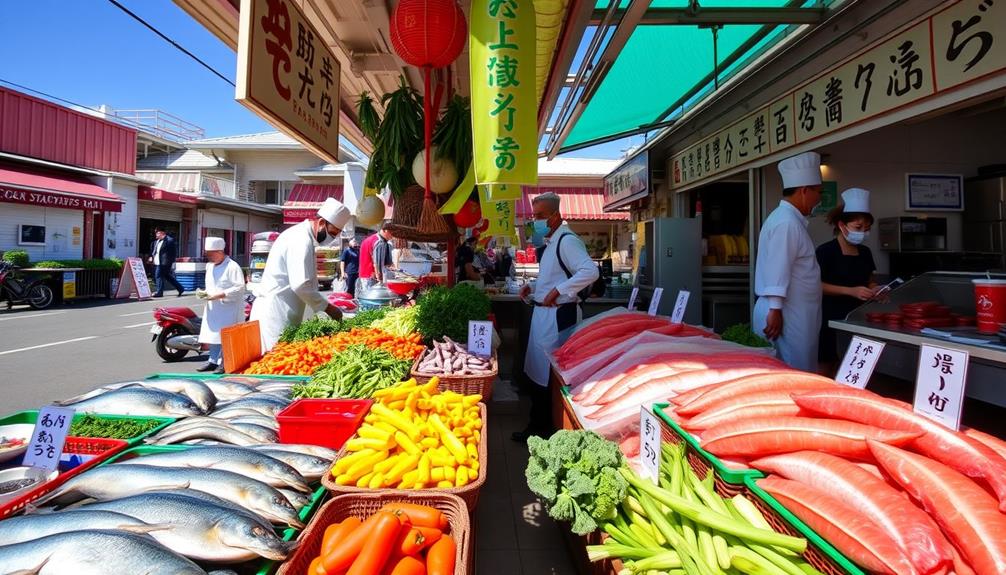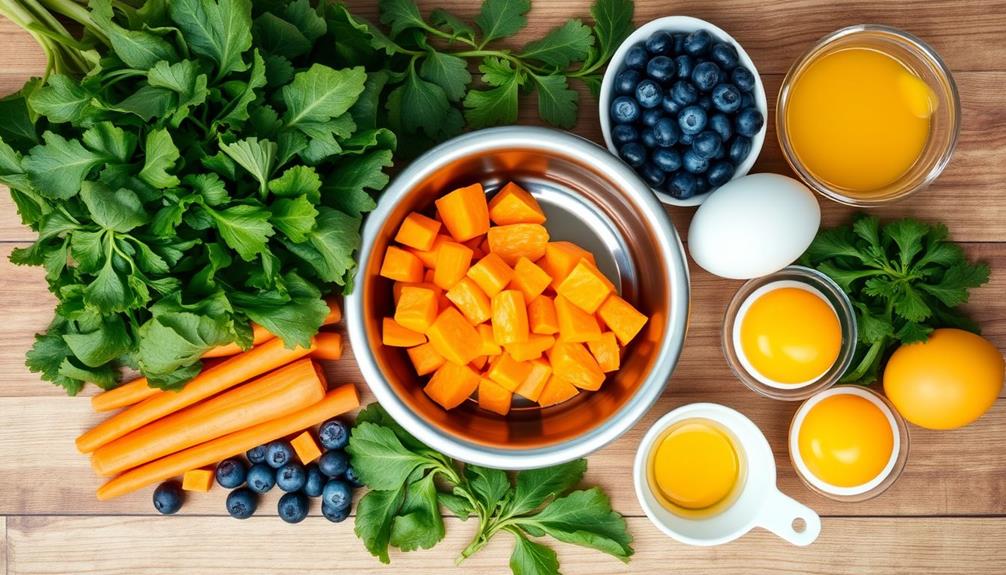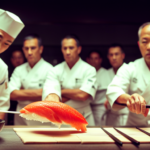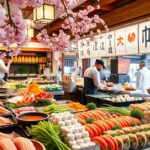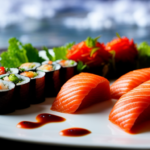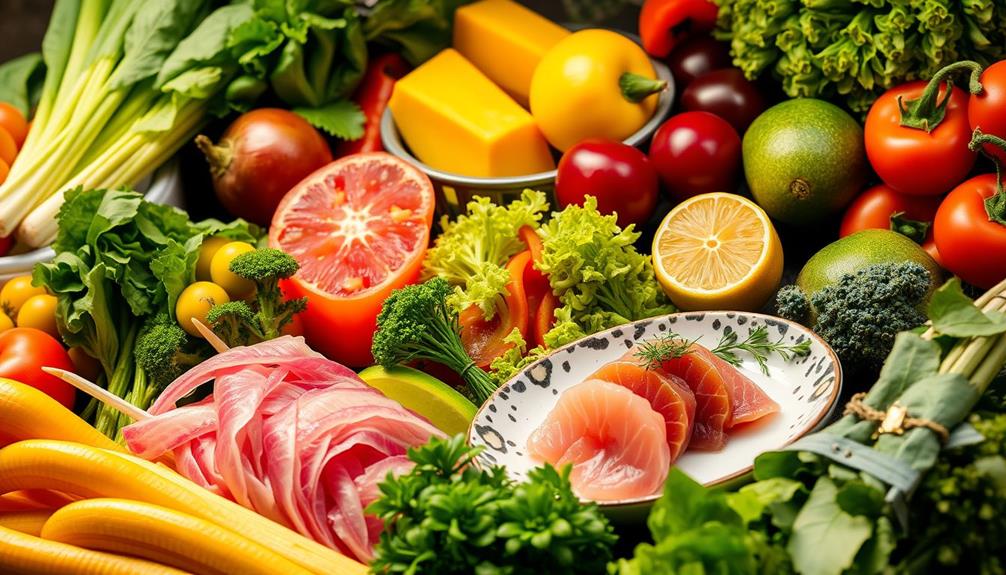Consuming raw food in Japan can be both thrilling and risky, especially with the growing trend of raw chicken dishes. While Japan maintains strict regulations for raw fish, the oversight for raw chicken isn't as stringent, raising food safety concerns. Young diners are particularly vulnerable to foodborne illnesses like Salmonella. To enjoy raw foods safely, choose reputable restaurants known for high hygiene standards and fresh ingredients. Always start with small portions to help your body adjust. If you're curious about safe dining options and practical tips, there's much more to explore on this flavorful journey!
Key Takeaways
- Japan has lenient regulations for raw chicken compared to raw fish, leading to increased consumption and potential food safety risks.
- Common pathogens associated with raw chicken, like Salmonella, pose significant health risks, particularly to younger consumers.
- Hygiene practices in restaurants are crucial; choosing reputable dining options with high sanitation standards can mitigate foodborne illness risks.
- Consumer education on safe handling and quality control is essential for reducing exposure to foodborne pathogens in raw dishes.
- Regular inspections and advanced safety technologies help maintain food safety standards, but awareness of personal health post-consumption remains vital.
Increase in Raw Chicken Consumption
In recent years, there's been a noticeable rise in the consumption of raw chicken in Japan, particularly among younger diners enthusiastic to explore new culinary trends. This shift reflects a broader appetite for unique dining experiences, and you might find dishes featuring raw chicken appearing more frequently on menus.
Government restrictions on raw beef and pork have pushed consumers to experiment with raw chicken, expanding their palate beyond traditional breast meat to include riskier cuts and even internal organs. However, it's vital to evaluate the potential side effects and interactions of raw food consumption, as highlighted in discussions on cold medications overview.
In prefectures like Saga and Miyazaki, the popularity of raw chicken has surged, yet it's important to acknowledge the implications of this trend. As you immerse yourself in the world of raw chicken, be aware that the current regulations surrounding its consumption are less stringent compared to other meats. This has raised concerns among food safety advocates, who emphasize the need for improved oversight and risk management strategies.
Ultimately, while the increase in raw chicken consumption showcases evolving culinary preferences, it also highlights the significance of education on food safety and hygiene practices. So, as you explore this trend, make informed choices and prioritize your health.
Food Safety and Poisoning Statistics
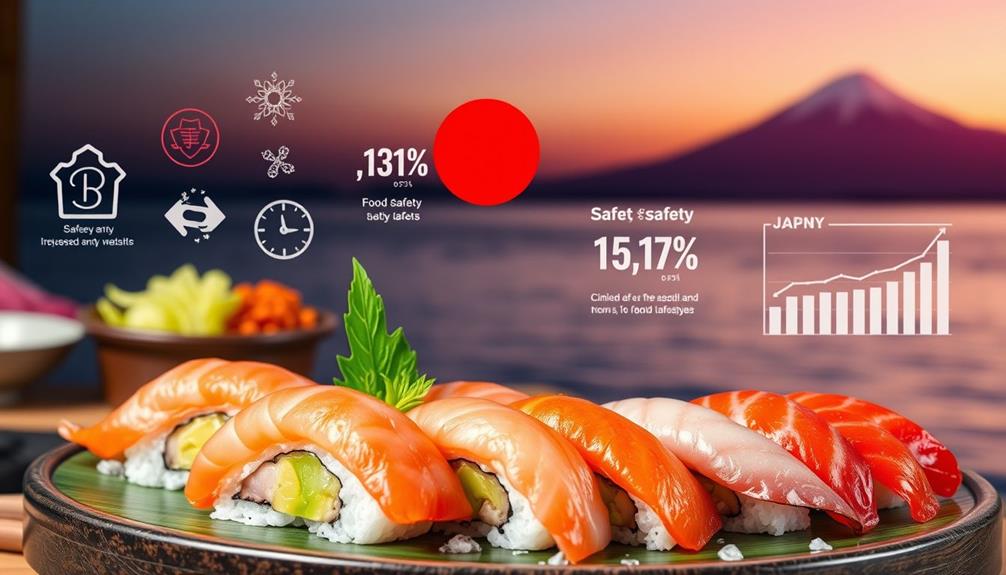
Food safety remains a pressing concern as raw chicken consumption rises in Japan. Analysis of government statistics reveals a troubling increase in food poisoning incidents, especially in prefectures like Saga and Miyazaki, where rates are particularly high.
Young consumers are particularly affected, as they engage more with raw chicken dishes, making them more vulnerable to food poisoning. This trend may be exacerbated by the lack of awareness surrounding the risks of BPD and emotional dysregulation that can affect decision-making in young adults.
The regulations surrounding raw chicken are considerably lax compared to stricter rules for other meats, raising significant public health concerns. This discrepancy highlights the need for improved food safety practices to protect consumers.
Geographic variations in food poisoning cases indicate that some regions may lack effective strategies for ensuring food safety, which further exacerbates the problem.
Comprehensive data on food poisoning trends is essential. It not only informs necessary changes in food safety regulations but also enhances consumer awareness about the risks associated with raw food consumption.
Regulatory Environment

Japan's regulatory environment for raw food, particularly raw chicken, raises significant public health concerns due to its leniency compared to other meats. Unlike the strict regulations imposed on raw fish and seafood, which require high freshness standards, the oversight for raw chicken remains remarkably relaxed.
This inconsistency has led to a growing alarm among health officials and consumers alike regarding the safety of high-risk food items. Understanding the impact of financial mistakes to avoid can also be vital for businesses in the food industry, as poor handling or regulation of food safety can lead to significant financial losses.
Different prefectures, such as Saga and Miyazaki, have implemented varying strategies for food safety and risk management related to raw chicken consumption. However, the current regulations lack the stringent oversight necessary to guarantee public safety.
This gap in regulation has fueled calls for improved measures, emphasizing the need for extensive oversight to mitigate the risks associated with consuming raw food in Japan.
You might wonder how this affects your dining choices. With the absence of rigorous standards, it's important to be cautious when consuming raw chicken and to stay informed about local regulations.
Cultural Context and Consumer Behavior

The evolving landscape of raw food consumption reflects a significant cultural shift, especially among younger consumers seeking adventurous culinary experiences. You might notice that these trends are deeply influenced by local traditions and social attitudes, showcasing a unique aspect of Japanese dining culture that embraces raw ingredients.
For instance, the rise of celebrity lifestyles often intersects with food trends, as seen in how public figures promote celebrity lifestyle insights that encourage adventurous eating.
Here's why raw food is gaining traction:
- Culinary Adventure: Young consumers are more willing to try riskier items, including dishes featuring raw chicken and internal organs.
- High Standards: Popular dishes like basashi (raw horse meat) and soft-boiled eggs highlight the importance of freshness and meticulous preparation in Japanese cuisine.
- Regional Variability: Different prefectures exhibit distinct culinary habits and safety practices, reflecting local preferences and risk management approaches.
Interviews with hygiene officials reveal that your attitudes toward raw foods stem from historical practices, regional availability, and perceptions of safety tied to food preparation standards.
As you explore Japan's culinary landscape, you'll see that the acceptance of raw food not only enriches your dining experience but also offers a glimpse into the country's evolving food culture.
Implications for Public Health

As you explore the implications of raw food consumption in Japan, it's clear that food poisoning risks are on the rise, particularly with raw chicken.
Mammography aims to detect potential health issues early, much like the need for proactive measures in food safety.
This situation highlights the urgent need for enhanced regulatory oversight and a focus on consumer education to guarantee safety.
Without these measures, public health could continue to face serious challenges.
Food Poisoning Risks
Raw food enthusiasts may find themselves traversing a landscape fraught with food poisoning risks, particularly in regions like Saga and Miyazaki, where incidents linked to raw chicken have surged.
The consumption of raw food can expose you to harmful pathogens, which are prevalent in Japan. This concern is amplified by the fact that certain raw foods, such as raw fish and eggs, carry specific risks that require careful handling and preparation to mitigate exposure to pathogens nutritional benefits include high fiber.
Common culprits include:
- Salmonella: Often found in raw chicken and eggs.
- Norovirus: A leading cause of gastroenteritis linked to raw seafood.
- Anisakis: A parasite found in raw fish that can cause severe digestive issues.
While Japan upholds stringent food safety regulations, the rising popularity of raw food dishes means that you need to remain vigilant.
A study conducted in 2010 showed that only a small percentage of eggs tested positive for Salmonella, indicating effective quality control. However, evolving consumer behaviors towards riskier foods highlight the necessity of education on safe consumption practices.
Regulatory Oversight Importance
Stringent regulatory oversight plays an essential role in guaranteeing the safety of raw food consumption in Japan. The country has established a thorough regulatory framework that emphasizes high hygiene standards throughout food production and handling. This framework is pivotal in mitigating health risks associated with raw food.
Regular inspections of restaurants and food establishments enforce compliance with food safety laws, markedly reducing the chances of foodborne illnesses linked to raw foods. In addition, the importance of risk management strategies can be observed in Japan's food safety protocols, which are designed to manage potential hazards effectively, thereby safeguarding public health and wellbeing.
Risk management strategies are indispensable for maintaining safety standards in various industries.
Specific prefectures like Saga and Miyazaki showcase the importance of localized strategies in food safety and risk management. By tailoring regulations to regional needs, these areas enhance public health outcomes.
Advanced technologies, including rapid bacterial detection and strict food storage protocols, additionally contribute to Japan's impressive low rates of food poisoning incidents, particularly concerning raw foods.
Public trust in the safety of raw food consumption is fortified by continuous investment in food safety innovations and effective quality control measures. These efforts guarantee that products consistently meet strict health standards.
Ultimately, regulatory oversight not only protects consumers but also promotes a culture of safety and responsibility in the raw food industry, ensuring that you can enjoy these delicacies with confidence.
Consumer Education Necessity
Consumer education plays an essential role in ensuring the safety of raw food consumption in Japan. As raw chicken consumption rises, especially among young consumers, understanding food safety becomes vital to prevent foodborne illnesses.
Despite Japan's high sanitation standards, the risk remains significant, particularly in regions like Saga and Miyazaki, where food poisoning rates linked to raw chicken are higher. To enhance safety, it's important to be aware of financial considerations for elderly care that can affect access to safe food options and health services.
To better protect yourself and your community, focus on these key areas of consumer education necessity:
- Safe Handling: Learn proper techniques for handling and preparing raw foods to minimize contamination risks.
- Expiration Awareness: Understand how to read expiration dates and recognize quality control measures, particularly for eggs, to reduce Salmonella exposure.
- Choosing Dining Options: Be selective about where you eat raw dishes—prioritize reputable restaurants that adhere to strict safety practices.
Understanding Food Poisoning Risks

Steering through the world of raw food can be thrilling, but it's vital to understand the food poisoning risks involved. Raw foods can harbor dangerous pathogens like salmonella, norovirus, and Anisakis, which pose significant health threats in Japan's culinary landscape.
When you indulge in these dishes, be aware that symptoms of food poisoning may include nausea, vomiting, diarrhea, and stomach cramps. It's important to guarantee that the establishments serving raw food adhere to proper hygiene standards, similar to the meticulous piercing care and hygiene practices one should follow for body piercings to avoid infections.
Japan takes food safety seriously, implementing strict regulations and regular inspections to minimize risks associated with raw food consumption. Thanks to these measures, the country reported only 124 cases of parasites in 2016 among its 130 million residents, showcasing the effectiveness of its food safety practices.
However, it's essential for you as a consumer to stay informed and make educated choices when enjoying raw dishes. Public awareness about food safety is deeply embedded in Japanese culture, encouraging you to pay attention to hygiene and sourcing when selecting raw food options.
Japanese Standards and Practices

Japan's commitment to food safety is evident in its strict regulations and practices for raw foods, especially when it comes to dishes like sushi and sashimi. To guarantee the safety of these raw dishes, several measures are in place:
- Flash-freezing: This process eliminates parasites, confirming that fish served in sushi and sashimi are safe for consumption. Additionally, the use of essential oils for oral health can complement dietary practices by promoting overall wellness.
- Regular inspections: Authorities conduct inspections to maintain compliance with food safety laws, assuring restaurants adhere to rigorous hygiene practices.
- Raw egg safety: Japan employs thorough cleaning and examination processes, along with advanced technology to detect bacterial contamination, considerably reducing the risk of Salmonella.
Additionally, Japan places a strong emphasis on consumer education initiatives aimed at promoting awareness of proper handling and consumption of raw dishes.
Stringent quality control measures, like the inclusion of expiration dates on egg packs, contribute to public health. Studies have shown a minimal incidence of Salmonella in tested eggs, reinforcing the effectiveness of these protocols.
With such rigorous standards and practices, you can enjoy Japan's famous raw dishes with confidence.
Tips for Enjoying Raw Foods

When you're ready to enjoy raw foods in Japan, start by choosing reputable restaurants known for their fresh ingredients.
It's smart to focus on places with high turnover rates and positive reviews to minimize any risks.
If you're new to raw dishes, begin with small portions to see how your body reacts.
Choose Reputable Establishments
Choosing the right restaurant is vital for safely enjoying raw foods. You want to guarantee that the establishment you pick follows strict hygiene practices and offers fresh ingredients. Here are some tips to help you choose a reputable spot:
- Check reviews: Look for positive feedback specifically mentioning food safety and cleanliness. This shows a commitment to high hygiene standards.
- Ask locals: Seek recommendations from locals or hotel staff, as they can guide you to places known for safe raw food options.
- Observe turnover: Prioritize establishments with high turnover rates, especially for sushi and sashimi. This assures the freshness of the ingredients.
Make certain the restaurant complies with Japanese food safety regulations, which mandate regular inspections for places serving raw food.
If you're new to raw dishes, start with small portions to help your body adjust safely. By following these guidelines, you can enjoy the rich flavors of raw food in Japan while minimizing any health risks.
Focus on Fresh Ingredients
To truly enjoy raw foods, focusing on the freshness of ingredients is essential. In Japan, you're in luck, as the country's proximity to the ocean guarantees quick delivery of fresh seafood. This notably reduces the risks associated with consuming raw fish and shellfish.
When you're savoring sushi or sashimi, make sure it meets high freshness standards, often involving immediate freezing at -40°C to eliminate pathogens.
If you're considering raw eggs, opt for those that have undergone rigorous cleaning and examination processes. This minimizes the risk of Salmonella contamination. Pay attention to expiration dates on egg packs; they're typically set for 1-2 weeks post-market entry, helping you gauge freshness and safety.
Thanks to advanced technology and strict regulations in food safety processes, you can trust the quality of fresh ingredients in Japanese cuisine.
Always prioritize freshness when choosing your raw foods, as this not only enhances flavor but also guarantees a safer dining experience. By being mindful of the ingredients you select, you'll truly appreciate the richness of Japan's raw food offerings.
Enjoy the vibrant flavors and textures that only the freshest ingredients can provide!
Start With Small Portions
Starting with small portions is a smart approach when trying raw foods in Japan. This method helps you gauge your body's reaction and minimizes any potential discomfort. Many restaurants that specialize in raw dishes prioritize freshness and quality, so sampling small amounts allows you to enjoy the flavors while evaluating safety.
Here are some tips for eating raw food safely:
- Choose well-known dishes: Start with familiar items like sushi or sashimi to help acclimate your palate.
- Check hygiene practices: Pay attention to the restaurant's cleanliness and look for customer reviews to guarantee a safe dining experience.
- Be mindful of sensitivities: If you have personal sensitivities or a weakened immune system, it's essential to start with small portions to avoid adverse reactions.
What to Do If You Feel Unwell
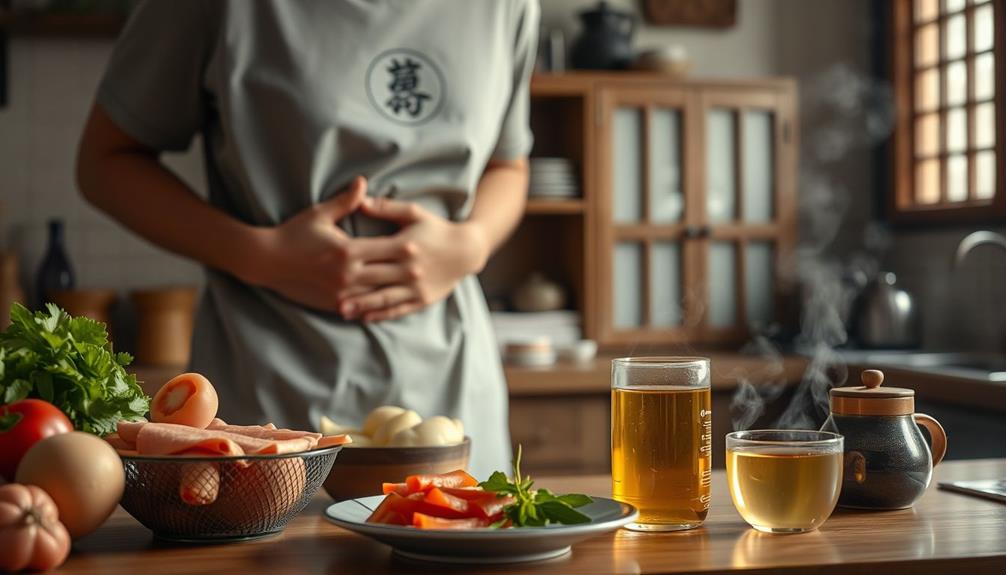
If you find yourself feeling unwell after consuming raw food in Japan, it's important to take action quickly. Common symptoms like nausea, vomiting, diarrhea, and stomach cramps can arise from mishandled food.
First, assess your symptoms; if they're severe or linger for more than a few days, don't hesitate to seek medical help. Japan boasts excellent healthcare facilities that can provide the support you need.
Hydration is essential during this time. Drink plenty of fluids, and consider using oral rehydration solutions to replenish lost electrolytes. Staying hydrated can help ease your discomfort and speed up recovery.
If your symptoms are mild, visit a local pharmacy where you can find over-the-counter products to alleviate them.
While eating raw food can be a delightful experience, being aware of what to do if you feel unwell is important. Prompt action can greatly reduce health risks associated with raw food consumption.
Frequently Asked Questions
Is It Safe to Eat Raw Food in Japan?
Eating raw food in Japan can be safe if you choose reputable restaurants and follow hygiene practices. Always check for freshness and trust your instincts; your health should always come first when enjoying raw dishes. When dining in Japan, it is also important to be wary of the potential risks associated with tofu and raw food. While tofu is a staple in Japanese cuisine, it is crucial to ensure that it is made with purified soybeans and prepared in a clean environment to avoid any contamination. Additionally, when consuming raw food such as sashimi or sushi, it is essential to confirm that the dish has been properly handled and stored to prevent foodborne illnesses. By being cautious and selective in your choices, you can greatly reduce the likelihood of encountering any health issues while enjoying raw food in Japan.
What Are the Food Safety Standards in Japan?
Japan's food safety standards are rigorous; only 3 out of 105,333 tested eggs showed Salmonella. You'll find strict regulations, regular inspections, and advanced technology ensuring high-quality food, making dining experiences safe and trustworthy.
Is It Safe to Eat Sushi Now in Japan?
You can enjoy sushi in Japan, as restaurants adhere to strict hygiene and freshness standards. Choosing reputable places guarantees your meal's safety, allowing you to savor authentic flavors without unnecessary worries about foodborne illnesses.
Should I Be Worried About Food Poisoning in Japan?
While food poisoning can feel like a lurking shadow, you shouldn't worry too much in Japan. Strict regulations and high hygiene practices keep risks low, allowing you to savor delicious dishes with confidence and peace.
Conclusion
In Japan, the rise in raw chicken consumption is fascinating, especially considering that about 50% of foodborne illness cases stem from raw or undercooked poultry. Understanding the strict regulations and cultural context surrounding raw foods can help you enjoy them safely. Always remember to follow best practices and stay informed about food safety. If you ever feel unwell, don't hesitate to seek medical advice. Enjoying raw foods can be thrilling, but your health should always come first!

